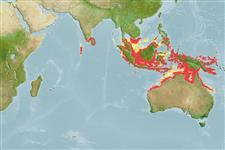Teleostei (teleosts) >
Tetraodontiformes (Puffers and filefishes) >
Triacanthidae (Triplespines)
Etymology: Triacanthus: Greek, tres, tria = three + Greek, akantha = thorn (Ref. 45335).
Eponymy: Johan Nieuhoff (1618–1672) was a Dutch traveller who wrote about his journeys to India, China and Brazil. [...] (Ref. 128868), visit book page.
More on author: Bleeker.
Environment: milieu / climate zone / depth range / distribution range
Ecology
Marine; demersal. Tropical; 10°N - 23°S, 73°E - 155°E
Indo-West Pacific: Arabian Sea, Bay of Bengal, Andaman Sea, Indonesia, South China Sea, northern Australia.
Size / Weight / Age
Maturity: Lm ? range ? - ? cm
Max length : 28.0 cm TL male/unsexed; (Ref. 9804)
Spiny dorsal-fin membrane very dark between first and second spines, slightly to much less darker between second and third spines, and pale between third and fifth spines. Outline of head between base of first dorsal-fin spine and eyes somewhat convex in front of spine and then straight or slightly concave over eye (Ref 9804).
Inhabits sandy and muddy flat in coastal areas. Feeds on benthic invertebrates. Marketed fresh.
Life cycle and mating behavior
Maturity | Reproduction | Spawning | Eggs | Fecundity | Larvae
Matsuura, K., 2001. Triacanthidae. Triplespines. p. 3905-3910. In K.E. Carpenter and V. Niem (eds.) FAO species identification guide for fishery purposes. The living marine resources of the Western Central Pacific. Vol. 6. Bony fishes part 4 (Labridae to Latimeriidae), estuarine crocodiles. FAO, Rome. (Ref. 9804)
IUCN Red List Status (Ref. 130435: Version 2024-1)
Threat to humans
Harmless
Human uses
Fisheries: minor commercial
Tools
Special reports
Download XML
Internet sources
Estimates based on models
Preferred temperature (Ref.
123201): 27.4 - 29.1, mean 28.5 °C (based on 524 cells).
Phylogenetic diversity index (Ref.
82804): PD
50 = 0.7578 [Uniqueness, from 0.5 = low to 2.0 = high].
Bayesian length-weight: a=0.01148 (0.00633 - 0.02083), b=2.91 (2.75 - 3.07), in cm total length, based on LWR estimates for this species & (Sub)family-body (Ref.
93245).
Trophic level (Ref.
69278): 3.5 ±0.37 se; based on food items.
Resilience (Ref.
120179): Medium, minimum population doubling time 1.4 - 4.4 years (Preliminary K or Fecundity.).
Fishing Vulnerability (Ref.
59153): Low vulnerability (18 of 100).
